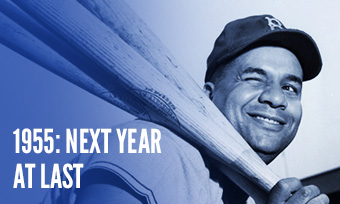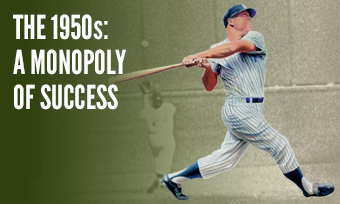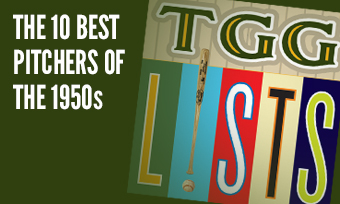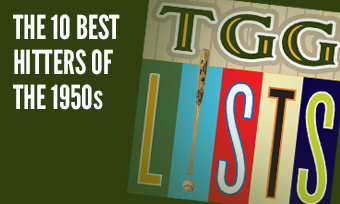The Yearly Reader
Leaders and Honors, 1955
Our list of baseball’s top 10 hitters and pitchers in both the American League and National League for the 1955 baseball season, as well as the awards and honors given to the game’s top achievers of the year.
The National League’s Top 10 Hitters, 1955
Bold type in brick red indicates league leader.
1. Willie Mays, New York
Key Numbers: .319 average, 123 runs, 185 hits, 18 doubles, 13 triples, 51 home runs, 127 RBIs, 79 walks, 24 stolen bases, .659 slugging percentage.
Mays was a sore sight for the eyes of Dodgers fans, cranking out nine homers at Ebbets Field—but how to explain his meager total of doubles given the spaciousness within his home park at the Polo Grounds?
2. Duke Snider, Brooklyn
Key Numbers: .309 average, 126 runs, 166 hits, 34 doubles, 6 triples, 42 home runs, 136 RBIs, 104 walks.
Snider’s continued monster output included the last three-homer performance by a Brooklyn Dodger. He might have won the MVP, but teammate Roy Campanella was given it under strange circumstances (see below).
3. Ted Kluszewski, Cincinnati
Key Numbers: .314 average, 116 runs, 192 hits, 25 doubles, 47 home runs, 113 RBIs, 25 intentional walks.
Kluszewski became an anomaly among NL sluggers of the time, wrapping up a three-year binge in which he collected more homers (136) than strikeouts (109).
4. Eddie Mathews, Milwaukee
Key Numbers: .289 average, 23 doubles, 5 triples, 41 home runs, 101 RBIs, 109 walks, 20 intentional walks.
Yet another 40-homer campaign, the third straight for Mathews—who would only surpass 40 one more time (in 1959) over his Hall-of-Fame career.
5. Wally Post, Cincinnati
Key Numbers: 154 games, .309 average, 116 runs, 186 hits, 33 doubles, 40 home runs, 109 RBIs, 102 strikeouts.
The 40 homers belted by the bust-out Post would have been good enough to lead the AL—but as a National Leaguer, he had to settle for sixth place.
6. Stan Musial, St. Louis
Key Numbers: 154 games, .319 average, 97 runs, 179 hits, 30 doubles, 5 triples, 33 home runs, 108 RBIs, 80 walks, 8 hit-by-pitches.
The Cardinals may have suffered their worst record (68-86) between 1924-78, but Musial was hardly to blame with his continued brilliance at age 34.
7. Ernie Banks, Chicago
Key Numbers: 154 games, .295 average, 98 runs, 176 hits, 29 doubles, 9 triples, 44 home runs, 117 RBIs.
Banks became the first shortstop to hit 40 homers; it was something the popular Cub would make a habit of it.
8. Roy Campanella, Brooklyn
Key Numbers: 123 games, .318 average, 81 runs, 32 home runs, 107 RBIs.
Campanella’s third MVP win might have been a mistake; one voter, said to be seriously ill, accidentally placed his name on the ballot twice. It nevertheless got counted.
9. Hank Aaron, Milwaukee
Key Numbers: .314 average, 105 runs, 189 hits, 37 doubles, 9 triples, 27 home runs, 106 RBIs.
In his second year, Aaron changed his jersey number from #5 to #44—and began playing like #44, doubling his home run output from his rookie showing.
10. Gus Bell, Cincinnati
Key Numbers: 154 games, .308 average, 88 runs, 188 hits, 30 doubles, 6 triples, 27 home runs, 104 RBIs.
Representing the first of at least three baseball generations, Bell quietly continued to be one of the Reds’ most consistent and sound hitters of the time—especially at cozy Crosley Field, where he hit .364.
The American League’s Top 10 Hitters, 1955
1. Mickey Mantle, New York
Key Numbers: .306 average, 121 runs, 25 doubles, 11 triples, 37 home runs, 99 RBIs, 113 walks, .611 slugging percentage.
Mickey Mantle ramped up the power (previous season home run high: 27) and nearly matched his famous tape measure shot of a couple years earlier in Washington by crushing a ball out of Chicago’s Comiskey Park and into a parked car, 550 feet away.
2. Al Kaline, Detroit
Key Numbers: .340 average, 121 runs, 200 hits, 25 doubles, 8 triples, 27 home runs, 102 RBIs, 82 walks.
Bucking the trend of “bonus baby” busts, Kaline became an immediate Detroit fixture with his most proficient of 22 seasons in the Motor City.
3. Ted Williams, Boston
Key Numbers: 98 games, .356 average, 77 runs, 21 doubles, 28 home runs, 83 RBIs, 91 walks, 17 intentional walks, .496 on-base percentage, .703 slugging percentage.
Another partial yet extraordinarily potent showing from Teddy Ballgame, this time due to a springtime return from early retirement. We’ll spare you the calculator and multiple his numbers out to a 154-game season: 44 home runs, 130 RBIs and 143 walks.
4. Jackie Jensen, Boston
Key Numbers: .275 average, 95 runs, 27 doubles, 6 triples, 26 home runs, 116 RBIs, 89 walks, 16 stolen bases, 12 sacrifice flies.
Jensen’s knack for knocking in runners continued, winning his first of three RBI titles while pacing the AL in sac flies for the second straight year.
5. Al Smith, Cleveland
Key Numbers: 154 games, .306 average, 123 runs, 186 hits, 27 doubles, 22 home runs, 77 RBIs, 93 walks, 15 hit-by-pitches, 11 stolen bases.
In his second full year, Smith stole the limelight usually reserved for Minnie Minoso by putting up Minoso-like numbers.
6. Larry Doby, Cleveland
Key Numbers: 131 games, .291 average, 91 runs, 26 home runs, 75 RBIs.
A wrist injury late in the year muted what likely would have been a much better year for Doby.
7. Vic Power, Kansas City
Key Numbers: .319 average, 91 runs, 190 hits, 34 doubles, 10 triples, 19 home runs, 76 RBIs.
The flamboyant Power, not Uncle Tom enough to be the Yankees’ first black player, received a more comforting welcome from the A’s and thanked them for it on the field.
8. Roy Sievers, Washington
Key Numbers: .271 average, 25 home runs, 106 RBIs, 73 walks.
Sievers wished that every day was a day against the A’s: Ten of his 25 homers came against Kansas City, eight of those among four multi-homer games to set a major league season record against one team.
9. Nellie Fox, Chicago
Key Numbers: 154 games, .311 average, 636 at-bats, 100 runs, 198 hits, 28 doubles, 7 triples, 6 home runs, 59 RBIs, 17 hit-by-pitches.
Fox tied a personal best with a whopping six homers—and here’s a fun fact: The future Hall of Famer hit more triples than home runs in each season from 1949-62.
10. Yogi Berra, New York
Key Numbers: .272 average, 84 runs, 27 home runs, 108 RBIs.
Leadership from the catcher’s spot helped carry Berra to a third AL MVP award, and barely, eclipsing Al Kaline and Al Smith in the vote.
The National League’s Top 10 Pitchers, 1955
1. Bob Friend, Pittsburgh
Key Numbers: 2.83 ERA, 14 wins, 9 losses, 44 appearances, 20 starts, 200.1 innings, 52 walks, 22 grounded into double plays.
Friend became the first ERA leader from a last-place team—and saved his best stuff from the bullpen, registering a 1.95 ERA in 24 relief appearances.
2. Warren Spahn, Milwaukee
Key Numbers: 3.26 ERA, 17 wins, 14 losses, 39 appearances, 32 starts, 245.2 innings.
His fastball fading, Spahn relied more on a newly-minted screwball, which certainly screwed with the heads of opponents who knew his baseball longevity would likely be extended.
3. Don Newcombe, Brooklyn
Key Numbers: 3.20 ERA, 20 wins, 5 losses, .800 win percentage, 31 starts, 233.2 innings, 38 walks, 22 grounded into double plays.
Newk got a whopping 7.1 runs per start, but he had something to do with that—hitting .359 with seven homers over 117 at-bats.
4. Joe Nuxhall, Cincinnati
Key Numbers: 3.47 ERA, 17 wins, 12 losses, 50 appearances, 33 starts, 257 innings, 5 shutouts, 31 grounded into double plays.
After famously debuting (and bombing) in the majors at age 15, Nuxhall completed his long and winding road toward a worthy All-Star Game roster spot.
5. Bob Buhl, Milwaukee
Key Numbers: 3.21 ERA, 13 wins, 11 losses, 38 appearances, 27 starts, 201.2 innings, 109 walks.
After a rough start, Buhl settled in, ascended to full-time rotation duty and placed the NL’s third-best ERA.
6. Johnny Antonelli, New York
Key Numbers: 3.33 ERA, 14 wins, 16 losses, 38 appearances, 34 starts, 235.1 innings, 11 hit-by-pitches.
Nobody expected Antonelli to pitch any better than his top-of-the-charts performance from the year before, but he certainly deserved a better record on a 3.33 ERA; he had to win his final four decisions just to upgrade the mark to so-so status.
7. Robin Roberts, Philadelphia
Key Numbers: 3.28 ERA, 23 wins, 14 losses, 3 saves, 41 appearances, 38 starts, 26 complete games, 305 innings, 53 walks.
Roberts won 20-plus games for the sixth straight (and last time), but it started to become apparent that the bill was coming due on his taxing workload; despite the quality ERA, he gave up more doubles, triples and home runs than any other NL pitcher—for the second of three straight years.
8. Bob Rush, Chicago
Key Numbers: 3.50 ERA, 13 wins, 11 losses, 33 starts, 234 innings, 23 stolen bases allowed.
A recent move to wearing glasses sharpened Rush’s numbers as well as his vision.
9. Clem Labine, Brooklyn
Key Numbers: 3.24 ERA, 13 wins, 5 losses, .722 win percentage, 11 saves, 60 appearances, 8 starts, 144.1 innings.
After a series of spot starts just didn’t work out, Labine was moved exclusively to the bullpen at the end of July and responded by winning four, saving nine and posting a 0.99 ERA over his final 29 appearances.
10. Willard Schmidt, St. Louis
Key Numbers: 2.78 ERA, 7 wins, 6 losses, 20 appearances, 15 starts, 129.2 innings.
Brought on at midseason, Schmidt looked to be on the verge of something big as opponents hit just .197 against him—but future years would repudiate his 1955 success.
The American League’s Top 10 Pitchers, 1955
1. Whitey Ford, New York
Key Numbers: 2.63 ERA, 18 wins, 7 losses, 39 appearances, 33 starts, 18 complete games, 253.2 innings, 113 walks, 34 grounded into double plays.
Ford pitched two of his three career one-hitters in back-to-back starts in early September—each time giving up the one hit in the seventh inning. (He never threw a no-hitter.)
2. Billy Pierce, Chicago
Key Numbers: 1.97 ERA, 15 wins, 10 losses, 33 appearances, 26 starts, 6 shutouts, 205.2 innings.
Pierce gave the majors its only sub-2.00 ERA between 1946-64—and it was even better in his home base at Comiskey Park, posting a 1.35 figure.
3. Early Wynn, Cleveland
Key Numbers: 2.82 ERA, 17 wins, 11 losses, 31 starts, 6 shutouts, 230 innings.
Wynn’s early path to another 20-win season was derailed by a rough patch in July and August; his 17 were still just one short of the league lead.
4. Billy Hoeft, Detroit
Key Numbers: 2.99 ERA, 16 wins, 7 losses, .696 win percentage, 29 starts, 7 shutouts, 220 innings.
Nearly half of Hoeft’s 16 wins were shutouts (seven), including three against lowly Washington.
5. Frank Sullivan, Boston
Key Numbers: 2.91 ERA, 18 wins, 13 losses, 35 starts, 260 innings, 100 walks.
Whereas Billy Pierce (above) gave the majors a rare view of sub-2.00 ERA pitching, Sullivan gave the Red Sox their only sub-3.00 ERA effort of the 1950s—and managed to win three more games than Pierce.
6. Bob Turley, New York
Key Numbers: 3.06 ERA, 17 wins, 13 losses, 34 starts, 6 shutouts, 246.2 innings, 177 walks, 210 strikeouts.
In his first year with the Yankees after a mammoth 17-player trade with Baltimore, Turley struggled to retain his wildness, but opponents still could only hit .193—and slug a remarkably low .282—against him.
7. Bill Wight, Cleveland-Baltimore
Key Numbers: 2.48 ERA, 6 wins, 8 losses, 3 saves, 36 appearances, 14 starts, 141.1 innings.
The veteran lefty was equally good as a reliever in Cleveland as he was a starter at Baltimore, even if the won-loss record didn’t reflect it.
8. Frank Lary, Detroit
Key Numbers: 3.10 ERA, 14 wins, 15 losses, 36 appearances, 31 starts, 235 innings, 28 grounded into double plays.
Al Kaline wasn’t the only rookie wowing ‘em in Detroit; the 25-year-old right-hander, despite a blasé record, easily showed that he would be a fixture for years to come.
9. Herb Score, Cleveland
Key Numbers: 2.85 ERA, 16 wins, 10 losses, 32 starts, 227.1 innings, 154 walks, 245 strikeouts, 12 wild pitches.
Beating out Kaline for Rookie of the Year honors, Score appeared to be perfect refresh tonic as aging Cleveland star pitchers Bob Feller, Bob Lemon and Mike Garcia began to fade.
10. Dick Donovan, Chicago
Key Numbers: 3.32 ERA, 15 wins, 9 losses, 29 appearances, 24 starts, 187 innings, 23 grounded into double plays.
After failing to hook on with either the Braves or Tigers, Donovan enjoyed a breakout campaign that stalled at the end of July when he was stricken with appendicitis; he was only 2-5 with a 5.17 ERA in eight appearances afterward to finish the season.









